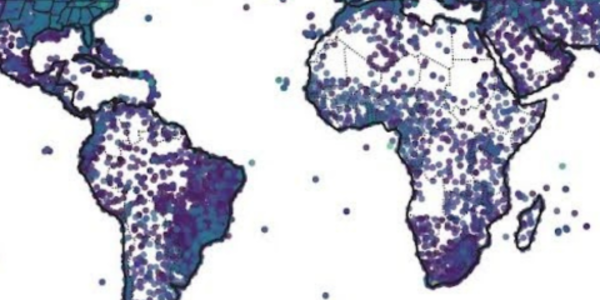U.S. Historical Climatology Network (USHCN) data are used to quantify national and regional-scale temperature changes in the contiguous United States (CONUS). The dataset provides adjustments for systematic, non-climatic changes that bias temperature trends of monthly temperature records of long-term COOP stations. USHCN is a designated subset of the NOAA Cooperative Observer Program (COOP) Network, with sites selected according to their spatial coverage, record length, data completeness, and historical stability.
Access Methods
Please see the readme file in the v2.5 directory for information on downloading and reading the v2.5 data. The status file provides information about the processing of the USHCN v2.5 data. Access data from the latest version (2.5) of the USHCN monthly via the HTTPS.
Citation
Cite the dataset version number and timestamp when using USHCN v2.5 data (as well as Menne et al. 2009) for analysis.

Pairwise Homogeneity Adjustment Software (USHCN)
Pairwise Homogeneity Algorithm (PHA) software (Menne and Williams 2009) version 52i is used to detect and adjust for documented and undocumented inhomogeneities in the USHCN version 2.5 monthly temperature dataset.
PHA version 52d was used to adjust the v2 dataset
Please refer to the readme file in these directories for guidance on how to download, deuncompress, compile, and run the pairwise homogenization software. The "tar/g zipped" file contains all of the necessary software to run the pairwise homogenization procedure. A simulated test dataset is included with the software along with a file of the expected output. Use the file of the expected output to verify proper execution of the code.
Versions
Version 2.5
Version 2.5 was released as a revision to the version 2.0 dataset In October 2012. The processing steps for version 2 and 2.5 are essentially the same, but the version number change reflects modifications to the underlying database as well as coding changes to the pairwise homogenization algorithm (PHA) that improve its overall efficiency. Table 1 (below) lists these modifications. NCEI Technical Reports GHCNM-12-01R (Williams et al., 2012a) and GHCNM-12-02 (Williams et al. 2012b) provide details regarding the PHA modifications.
| Version 2.0 | Version 2.5 | |
|---|---|---|
| Database construction and quality control | Monthly mean maximum and minimum temperatures (and total precipitation) were calculated using three daily datasets archived at NCDC (DSI-3200, DSI-3206 and DSI-3210). The daily values were first subject to the quality control checks described in Menne et al. 2009 and only those values that passed the evaluation checks were used to compute monthly average temperatures. Monthly averages were computed only when no more than 9 daily values were missing or flagged by the quality checks. Monthly values calculated from the three daily data sources then were merged with two additional sources of monthly data (DSI 3220 and the USHCN version 1) to form a more comprehensive dataset of serial monthly temperature and precipitation values for each HCN station. Duplicate records between data sources were eliminated and values from the daily sources were used in favor of values from the two monthly sources. DSI 3200 was used in favor of the USHCN v1 database. Monthly values were subject to a separate suite of checks as described in Menne et al. 2009 |
Monthly mean maximum and minimum temperatures (and total precipitation) were calculated using GHCN-Daily (Menne et al. 2012). The daily values are first subject to the quality control checks described in Durre et al. (2010). Only those values that pass the GHCN-Daily QC checks are used to compute the monthly values. Further, a monthly mean is calculated only when nine or fewer daily values are missing or flagged. Monthly values calculated from GHCN-Daily are merged with the USHCN version 1 monthly data to form a more comprehensive dataset of serial monthly temperature and precipitation values for each HCN station. Duplicate records between data sources were eliminated and values from GHCN-Daily are used in favor of values from the USHCN version 1 raw database. USHCN version 1 data comprise about 5% of station months, generally in the earliest years of the station records. Monthly mean temperature values are then subject to an addition set of monthly QC tests as described in Lawrimore et al. (2011). |
| Pairwise Homogenization Algorithm (PHA) Version Number | 52d (source code) | 52i (source code) |
| Re-processing frequency |
The raw database was constructed in 2006 using the sources described above (and in Menne et al. 2009) and updated thereafter with monthly values computed from GHCN-Daily. The temperature data were last homogenized by the PHA algorithm in May 2008. Since May 2008, more recent data have been added to the homogenized database using the monthly values computed from GHCN-Daily (but without re-homogenizing the dataset). |
The raw database is routinely reconstructed using the latest version of GHCN-Daily, usually each day. The full period of record monthly values are re-homogenized whenever the raw database is re-constructed (usually once per day) |
| Data format | Six-digit station identification number One data value flag (see the version 2 readme.txt file for details). | Eleven-digit station identification number similar to that used in GHCN-Daily. A network code of ‘H’ is used and the last six-characters of the id are the coop identification number. Three flags accompany each monthly values (data measure flag, data quality flag, data source flag) as in GHCN-Monthly version 3 [see the version 2.5 readme.txt file for details) |
| Version Control/Time Stamping | Data files labeled with the latest available data month (e.g., 9641C_yyyymm.dataset.element.gz; whereyyyy=year and mm=month; dataset=raw, tob, or F52; and, element=max. min, avg, or pcp) | Data files are all of the format ushcn.element.latest.dataset.tar.gz where element=tmax, tmin, tavg, or prcp; and, dataset=raw, tob, or FLs.52i. The data will untar/uncompress into a directory called ushcn.version.date whereversion=2.5.0 and date=the year, month and day (yyyymmdd) that the data were last reprocessed and updated. |
Version 2
Version 2 monthly temperature data incorporated an expanded database of raw temperature values from COOP stations, a new set of quality control checks, and a more comprehensive homogenization algorithm. The version 2 temperature dataset and processing steps detailed description are in Menne et al. (2009).
Version 1
Version 1 is made up of three dataset releases (described in Quinlan et al. 1987, Karl et al., 1990 and Easterling et al., 1996). These datasets contained adjustments to the monthly mean maximum, minimum, and average temperature data that addressed potential documented in NCEI’s station history archives. The documented changes that were addressed include changes to the time of observation (Karl et al. 1986), station moves, and instrument changes (Karl and Williams, 1987; Quayle et al., 1991). Apparent urbanization effects were also addressed in version 1 with a specific urban bias correction (Karl et al. 1988).
In 2007, USHCN version 2 serial monthly temperature data were released and updates to the version 1 datasets were discontinued.
Purpose
Since 1987, NCEI has used observations from the U.S. Historical Climatology Network (USHCN) to quantify national and regional-scale temperature changes in the conterminous United States (CONUS). USHCN temperature records are corrected to account for various historical changes in station location, instrumentation, and observing practice. This network of stations is a designated subset of the NOAA Cooperative Observer Program (COOP) Network. USHCN sites were included in the COOP network based on spatial coverage, record length, data completeness, and historical stability.
The USHCN consists primarily of adjustments for systematic, non-climatic changes that bias temperature trends of monthly temperature records of long-term COOP stations.
History
USHCN datasets were originally developed at the former National Climatic Data Center (NCDC) in collaboration with the Department of Energy (DOE) Carbon Dioxide Information Analysis Center (CDIAC) in the mid-1980s (Quinlan et al. 1987). The project was launched by personnel at DOE Global Change Research Program and NCDC with the goal of developing an accurate, unbiased, up-to-date historical climate record for the United States. Their first step was to define a network of 1219 stations in the contiguous United States to provide observations for a key baseline dataset for monitoring U.S. climate.
Station Siting and U.S. Surface Temperature Trends
Photographic documentation of poor siting conditions at stations in the USHCN has led to questions regarding the reliability of surface temperature trends over the conterminous U.S. (CONUS). To evaluate the potential impact of poor siting/instrument exposure on CONUS temperatures, Menne et al. (2010) compared trends derived from poor and well-sited USHCN stations using both unadjusted and bias-adjusted data. Results indicate that there is a mean bias associated with poor exposure sites relative to good exposure sites in the unadjusted USHCN version 2 data; however, this bias is consistent with previously documented changes associated with the widespread conversion to electronic sensors in the USHCN during the last 25 years Menne et al. (2009). The sign of the bias is counterintuitive to what would be expected from poor exposure because associated instrument changes have led to an artificial negative ("cool") bias in maximum temperatures and only a slight positive ("warm") bias in minimum temperatures.
Adjustments applied to USHCN Version 2 data largely account for the impact of instrument and siting changes, although a small overall residual negative (“cool”) bias appears to remain in the adjusted USHCN version 2 CONUS average maximum temperature (see also Fall, S. 2011). Nevertheless, the adjusted USHCN CONUS temperatures are well aligned with recent measurements from the U.S. Climate Reference Network (USCRN). This network was designed with the highest standards for climate monitoring and has none of the siting and instrument exposure problems present in USHCN. The close correspondence in nationally averaged temperature from these two networks is further evidence that the adjusted USHCN data provide an accurate measure of the U.S. temperature.
The Menne et al. (2010) results underscore the need to consider all changes in observation practice when determining the impacts of siting irregularities. Further, the influence of non-standard siting on temperature trends can only be quantified through an analysis of the data which do not indicate that the CONUS average temperature trends are inflated due to poor station siting.
Scientists used four sets of USHCN stations in the Menne et al. (2010) analysis. Set 1 includes stations identified as having good siting by the volunteers at surfacestations.org. Set 2 is a subset of Set 1 consisting of the Set 1 stations whose ratings are in general agreement with an independent assessment by NOAA’s National Weather Service. Set 3 are those stations with moderate to poor siting ratings according to surfacestations.org. Set 4 is a subset of Set 3 consisting of the Set 3 stations whose ratings are in agreement with an independent assessment by NOAA’s National Weather Service. For further information, please see Menne et al. (2010). The set of Maximum Minimum Temperature Sensor (MMTS) stations and Cotton Region Shelter (Stevenson Screen) sites used in Menne et al. (2010) are also available (see the "readme.txt" file as described below for a description of the station list format). Access to the unadjusted, time of observation adjusted, and fully adjusted USHCN Version 2 temperature data is described below.



